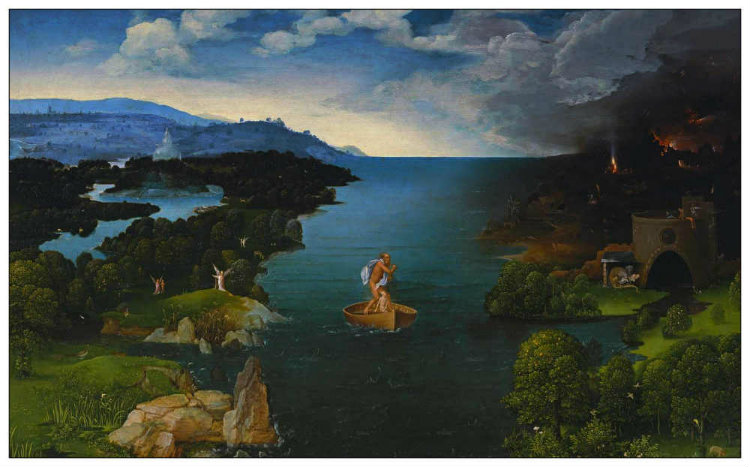Search:: Artists Alphabetically Artists by Country Artists by Century Artists by Movement
The concept of World Landscape or Weltlandschaft originated with Flemish artist Joachim Patinir. Patinir is considered the first landscape painter in the history of Western art. His landscapes are mythological and religious themed with moralizing overtones.
Landscape with Charon Crossing the Styx by Joachim Patinir c.1519, Prado Museum, Madrid
Landscape with Charon Crossing the
Styx depicts a classic subject from the Aeneid and
Inferno , in which Charon ferries a human soul who must decide
between heaven and hell. In Greek mythology the Charon was the ferryman
of the dead, an underworld spirit in the service of the King
of Hell. Heaven is on the left side with angels and a river leading to
a luminous white building in the background. Hell is on the opposite
side, dingier and darker with eternal fires buring in the
city of the damned. The ferryman appears nervous and sly. The water
becomes darker upon approach. The hesitant spirit must choose between
right and wrong.
Joachim Patinir was born in Belgium. He became one of the most important Northern Renaissance painters working in Antwerp in the 15th Century. His landscapes immediately became acclaimed for their atmospheric, ethereal beauty and unbelievable technical precision.
Important Words, People, Phrases, Characteristics related to the Northern Renaissance Art Movement - allegorical painting, rebirth, invention of oil painting, Hieronymus Bosch, Limbourg Brothers, Desiderius Erasmus, Robert Campin, Jan Van Eyck, Jean Fouquet, Albrecht Dürer, Johannes Gutenberg, Johann Reuchlin, Martin Luther, rise of the merchant class, world landscape, Low Countries, Protestant Reformation, Calvinisim, glazing, impasto, scriptorium, illuminator, invention of the printing press, woodcuts, engravings, Antwerp School, Guild of Saint Luke, commerce, Flemish School, Northern Europe, Antwerp School, Flanders, Bruges, renewed interest in classical learning, mythological scenes, genre painting, landscapes, portraits, moralizing overtones, human vices, lust, paradise, spirituality, piousness, living a simple life, reform, Human Reasoning, tradesmen at work, idyllic scenes of peasants, playing games, feasting, linear perspective, \Heliocentric Theory, humour, satire, spiritually significant, illuminated manuscript, idealized biblical themes, scriptorium, emotion, illuminator, iconoclast, Age of Discovery, Virgin and Child, axonometric drawing, curiosity about the natural world, realistic use of colours and light, Old Testament stories, Gospel parables, The Blackdeath, Christian symbolism
If you feel you have worthwhile information you would like to contribute we would love to hear from you. We collect essential biographical information and artist quotes from folks all over the globe and appreciate your participation. When submitting please, if possible, site the source and provide English translation. Email to millardmulch@gmail.com
☼☼☼☼☼
© HistoryofPainters.com If you like this page and wish to share it, you are welcome to link to it, with our thanks. updated 4/2017